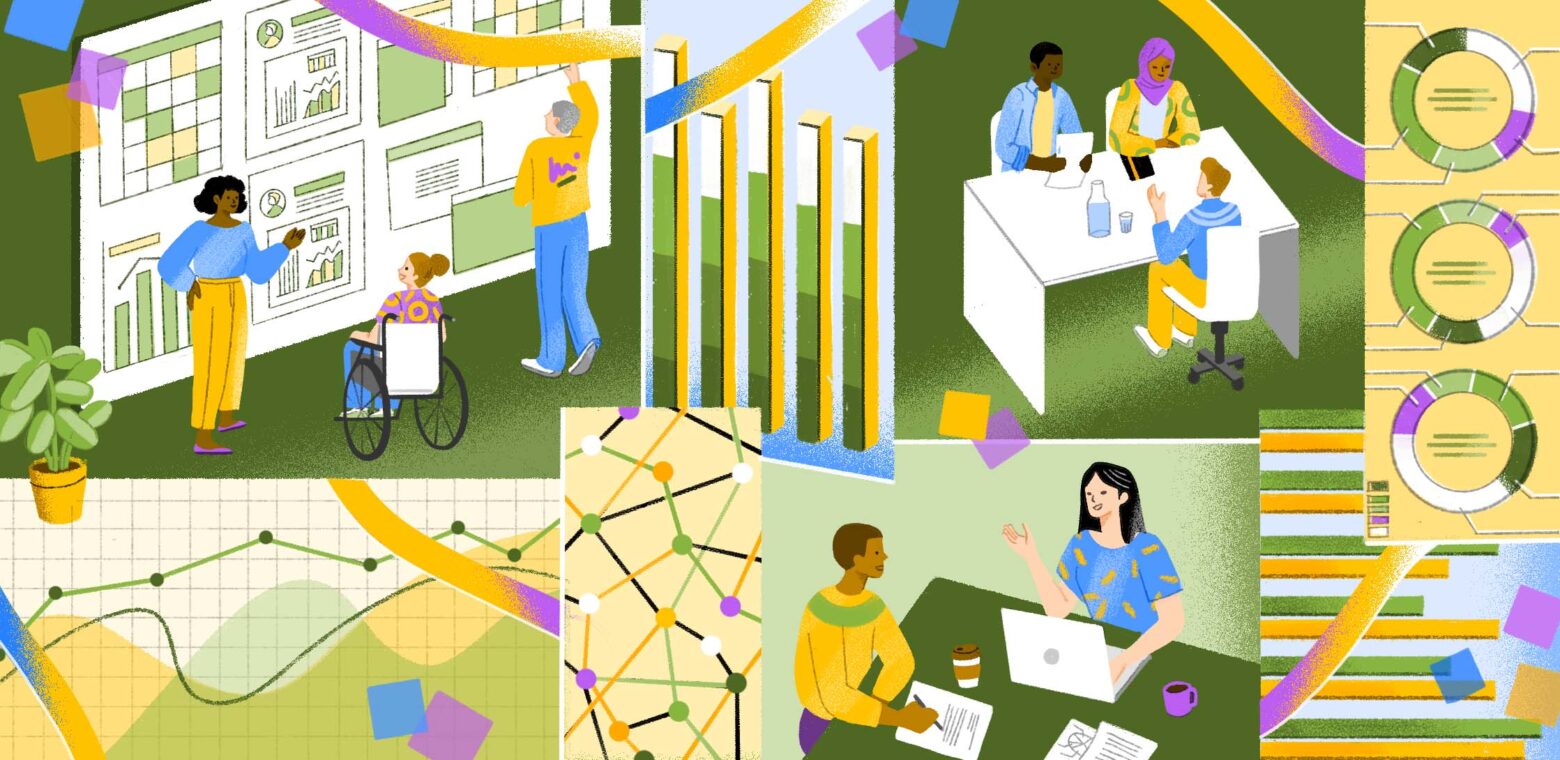3 ways to center equity in the workplace
Here’s how to minimize the biases that often show up across the employee lifecycle.
Many organizations want to achieve equity in the workplace, but very few succeed in prioritizing it in a systematic, consistent way across their organization.
Let’s start with an illustrative example. Imagine a company is hiring for a role requiring “effective communication” competency. The interviewer may be asked to evaluate this competency using the following criteria:
“Listens attentively, uses body language (e.g. eye contact, nodding head,) to show receptiveness to others; Interprets others verbal and nonverbal cues to identify areas of interest or concern; Confirms understanding by asking thoughtful questions to clarify unstated expectations; Delivers responses concisely in a format that resonates and can be easily interpreted by the audience.”
But let’s unpack this language: It’s not entirely fair to expect employees at a global company (some of whom come from different cultural and communication backgrounds, and may have learned English as a second language) to be able to identify “body language” or “unstated expectations.” Interpreting “nonverbal cues” can pose problems for some neurodivergent folks. And, if used as it’s currently written, we might expect the hiring manager’s personal preferences to come into play, whether they favor U.S./Western norms and/or employees from majority groups to be favored; this could compound into group-level performance, promotion, and pay disparities over time.
A better version might look like this, accompanied with job group-specific examples of different ways to exhibit this successfully:
“Listens attentively, and confirms understanding of information or asks questions to clarify. Relays information clearly, and works on adjusting to fit the audience/message and selects appropriate form(s) of communication.“
Taking notice of these details and intentionally redefining evaluation criteria is just one important way organizations can build systems that center equity.
What is equity, anyway?
While there are many definitions of equity, on the Diversity, Equity, and Inclusion team at Atlassian we think of equity as accounting for the structural advantages and disadvantages that contribute to group-level demographic disparities. This often means proactively designing people processes to minimize (and ideally uproot) the biases that often show up across the employee lifecycle, including how we hire, evaluate performance, give promotions, reward and pay employees, and carry out everyday team ways of working such as running team meetings, assigning work, and communicating decisions and information.
Focusing on equity requires us to hone in on the context, history, and experiences of historically marginalized and underrepresented employees, while tuning in to the ways companies unintentionally design systems that favor people from majority groups – and intentionally adjust for these.
Here are three ways organizations can begin centering equity in the workplace.
1. Design a fair system of people processes
One of the most important ways companies can improve equity is to design people processes that reduce common biases and accessibility barriers, which disadvantage historically marginalized employees.
Build structured processes with objective, pre-defined criteria
Hiring, performance, promotion, and pay processes should be structured to help managers mitigate bias by ensuring they ground their decision in objective, pre-defined criteria. Studies have shown that when evaluations lack these explicit guardrails, we shift the criteria for decision-making and rely more heavily on stereotypes. Structured processes also have the added benefit of being easier to explain to all employees and build trust – everyone is on the same page.
When you’re hiring for a role, begin by writing down the key skills and experiences that are necessary for success in the role, and use them as the criteria for assessment as you engage in the resume review, interviews, work samples, and eventual offer decision.
As you design your interview questions, and ideally a skills-based work sample, make sure you design them to assess for the pre-defined critical skills and experiences, and make sure to create a simple rubric in advance of what a great, adequate, and inadequate answer would look like so the team can make more consistent and fair decisions.
Require managers to provide clear justification of their assessment criteria.
It’s often not enough to simply define criteria; you need to hold individuals accountable for the decisions around that criteria.
Research shows that adding structured prompts to manager feedback forms can help reduce demographic gaps in performance reviews. For example, you could ask “Did you collect the following evidence/data for this employee over the past 6 months?” accompanied by the list of agreed-upon performance criteria.
⚠️ Pro tip: It may make more sense for your organization use a people system and performance management tool that has bias mitigation features built in like Greenhouse, Lattice, and Textio.
2. Follow through on equitable process commitments
Even the most equitably designed processes and systems won’t be effective without consistent follow-through by the people using them. The first step is equipping process owners and decision-makers (e.g., senior leaders, People/HR team members, people managers) – with the resources and skills to mitigate bias, and holding them accountable to carry out equitable processes.
What leaders and People/HR process owners can do to drive follow-through:
Assess how consistently managers and leaders are following through on people processes.
Try asking a sample of managers and HRBPs across the business how consistently they see processes being followed, where there tends to be more variability, and what challenges they’ve seen in implementing processes consistently. From these informal interviews, you can start tracking the deviations from outlined processes, where there may be overlapping processes, and where there may be unclear expectations or interpretations of processes.
Identify opportunities to drive greater consistency
Once you assess for variability and deviations, you can begin to incorporate systems and structures that ensure greater consistency. Consider adding “nudges” to your performance management process communications, especially for those steps that tend to be rushed or simplified.
Example performance management nudge
A reminder before you start your reviews: For each of your reports, remember to ground your rating and feedback in ample supporting evidence against each performance assessment criteria, and make sure your assessment is aligned to their specific role and level expectations. Before you close out your team’s reviews, do a quick check across your team to see if you’ve given balanced positive and critical feedback for each of your employees, and aren’t overly scrutinizing or rewarding some team members over others.
What managers can do to drive follow-through:
Revisit the ways bias can creep into your decision-making every time you make hiring, performance, promotion, and pay decisions
Don’t know where to start? Here are a few public resources good for beginners:
- Giving equitable feedback from Textio
- Types of performance review biases and how to avoid them from Culture Amp
- Inclusive Leadership from Paradigm
Use a checklist to hold yourself accountable to structured, fair, and objective decision-making
Here are some reminders you might include on your checklist:
- Review the process and guidelines ahead of time.
- Review expectations for employees’ role and rank each time you give feedback and assess performance.
- Before submitting feedback, review it to make sure it’s relevant, constructive, and actionable, and avoids personality feedback.
3. Measure for improvement over time
Cultivating and maintaining equitable experiences and outcomes for employees doesn’t stop once we’ve redesigned a process or done some training; we need to monitor for inequitable outcomes on a regular basis, and work to ensure that our ongoing processes are not unintentionally disadvantaging historically marginalized groups.
To do this, establish an ongoing cadence of health checks to analyze employee outcomes, analyze the impact of your interventions, and iterate your approach accordingly moving forward. Are the interventions and process design updates you’re making having the impact you intended? What is the data telling you about your existing gaps and opportunity areas, and where you might focus to maximize your impact for underrepresented and historically marginalized groups?
What leaders and people/HR process owners can do to ensure improvement over time
Analyze key people outcomes by demographic groups
These groups may include age, gender, race/ethnicity, level of education, disability status, and veteran status.
- Applicant data: Hiring rates, applicant pool representation, pass-through rates, sourcing rates
- Employee data: Representation, attrition, performance rating distribution, promotion rates, pay
- Survey and/or qualitative data: candidate experience, offer decline reason, employee experience/ inclusion survey, attrition reason
If you’re just getting started on your data journey, there are many articles and resources out there that can help you on your data journey. Here are a few we like:
Begin with the end in mind
As you’re designing a process, consider how you’ll measure its impact, ensure the implementation and outcomes are executed as intended, and that they’re equitable across groups. What questions will you want to be able to answer? How will you ensure that you have the data you will need later in order to measure your impact?
If you’re redesigning your performance management process, you should not only measure outcomes, but also user experiences and perceptions. Plan ahead for an employee pulse surveys that assess managers’ and ICs’ perceptions of program fairness before and after program changes.
What manager and ICs can do to ensure improvement over time
To the extent that you feel comfortable doing so, fill out your organization’s self-identity demographic surveys (often completed at onboarding in organizations that already have data in place, or you might have a separate survey asking to collect your data),
If and when your company shares any demographic data (often representation data, but can be more extensive) at either the company or team level, spend time understanding the data, share any questions you might have, and ask what’s being done to improve. This helps make it clear that you care about continuing to have transparent access to data, and are invested in ongoing improvement and continued prioritization of equity.
Every company – no matter the size, industry, or location – has an opportunity and responsibility to ensure that the processes in places, the systems you use, and the practices/behaviors that you encourage are designed with equity top of mind. At Atlassian, our own journey to a more equitable workplace is ongoing, and we’re eager to share more as we make progress on our goals.












































